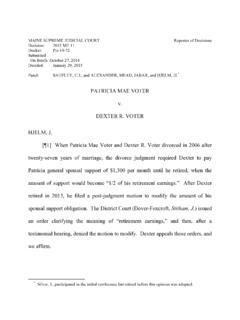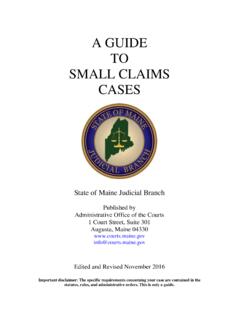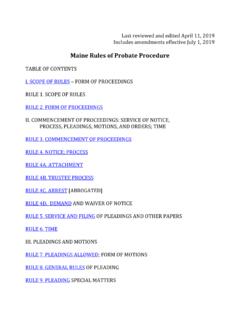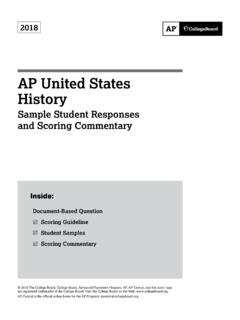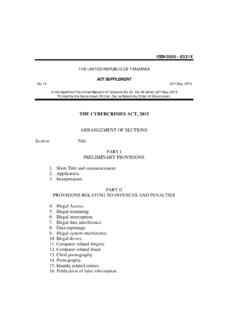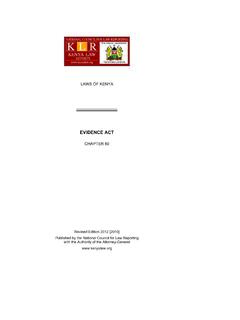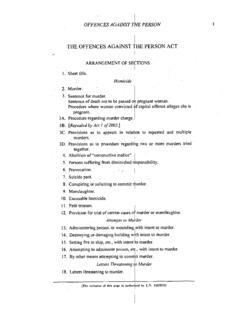Transcription of MAINE RULES OF EVIDENCE - Maine Judicial Branch
1 1 Last reviewed and edited June 29, 2018 Includes amendment effective August 1, 2018 MAINE RULES OF EVIDENCE TABLE OF RULES ARTICLE I. GENERAL PROVISIONS RULE 101. APPLICABILITY; DEFINITIONS; TITLE RULE 102. PURPOSE. RULE 103. RULINGS ON EVIDENCE RULE 104. PRELIMINARY QUESTIONS. RULE 105. LIMITING EVIDENCE THAT IS NOT ADMISSIBLE AGAINST OTHER PARTIES OR FOR OTHER PURPOSES RULE 106. REMAINDER OF OR RELATED WRITINGS OR RECORDED STATEMENTS ARTICLE II. Judicial NOTICE RULE 201. Judicial NOTICE OF ADJUDICATIVE FACTS ARTICLE III. PRESUMPTIONS RULE 301. PRESUMPTIONS IN CIVIL CASES GENERALLY RULE 302. PRESUMPTION OF LEGITIMACY RULE 303. PRESUMPTIONS IN CRIMINAL CASES ARTICLE IV. RELEVANCE AND ITS LIMITS RULE 401. TEST FOR RELEVANT EVIDENCE RULE 402. GENERAL ADMISSIBILITY OF RELEVANT EVIDENCE 2 RULE 403. EXCLUDING RELEVANT EVIDENCE FOR PREJUDICE, CONFUSION, WASTE OF TIME, OR OTHER REASONS RULE 404. CHARACTER EVIDENCE ; CRIMES OR OTHER ACTS RULE 405. METHODS OF PROVING CHARACTER RULE 406.
2 HABIT; ROUTINE PRACTICE RULE 407. SUBSEQUENT REMEDIAL MEASURES; NOTIFICATION OF DEFECT RULE 408. COMPROMISE OFFERS AND NEGOTIATIONS RULE 409. OFFERS TO PAY MEDICAL AND SIMILAR EXPENSES RULE 410. PLEAS, PLEA DISCUSSIONS, AND RELATED STATEMENTS RULE 411. LIABILITY INSURANCE. RULE 412. SEX-OFFENSE CASES: THE VICTIM S SEXUAL BEHAVIOR OR PREDISPOSITION. RULE 413. PROTECTION OF PRIVACY IN COURT PROCEEDINGS. ARTICLE V. PRIVILEGES RULE 501. PRIVILEGES RECOGNIZED ONLY AS PROVIDED BY LAW RULE 502. LAWYER-CLIENT PRIVILEGE RULE 503. HEALTH CARE PROFESSIONAL , MENTAL HEALTH PROFESSIONAL , AND LICENSED COUNSELING PROFESSIONAL-PATIENT PRIVILEGE RULE 504. SPOUSAL PRIVILEGE RULE 505. RELIGIOUS PRIVILEGE 3 RULE 506. POLITICAL VOTE RULE 507. TRADE SECRETS RULE 508. SECRETS OF STATE AND OTHER OFFICIAL INFORMATION; GOVERNMENTAL PRIVILEGES RULE 509. IDENTITY OF INFORMANT RULE 510. WAIVER OF PRIVILEGE BY VOLUNTARY DISCLOSURE RULE 511. PRIVILEGED MATTER DISCLOSED UNDER COMPULSION OR WITHOUT OPPORTUNITY TO CLAIM THE PRIVILEGE RULE 512.
3 COMMENT UPON OR INFERENCE FROM CLAIM OF PRIVILEGE IN CRIMINAL CASES; INSTRUCTION RULE 513. CLAIM OF PRIVILEGE IN CIVIL CASES RULE 514. MEDIATOR S PRIVILEGE ARTICLE VI. WITNESSES RULE 601. COMPETENCY TO TESTIFY IN GENERAL RULE 602. NEED FOR PERSONAL KNOWLEDGE RULE 603. OATH OR AFFIRMATION TO TESTIFY TRUTHFULLY RULE 604. INTERPRETERS RULE 605. JUDGE S COMPETENCY AS A WITNESS RULE 606. JUROR S COMPETENCY AS A WITNESS RULE 607. WHO MAY IMPEACH A WITNESS 4 RULE 608. A WITNESS S CHARACTER FOR TRUTHFULNESS OR UNTRUTHFULNESS RULE 609. IMPEACHMENT BY EVIDENCE OF A CRIMINAL CONVICTION RULE 610. RELIGIOUS BELIEFS OR OPINIONS RULE 611. MODE AND ORDER OF EXAMINING WITNESSES AND PRESENTING EVIDENCE RULE 612. WRITING USED TO REFRESH A WITNESS S MEMORY RULE 613. WITNESS S PRIOR STATEMENTS RULE 614. COURT S CALLING OR EXAMINING A WITNESS RULE 615. EXCLUDING WITNESSES RULE 616. ILLUSTRATIVE AIDS ARTICLE VII. OPINIONS AND EXPERT TESTIMONY RULE 701. OPINION TESTIMONY BY LAY WITNESSES RULE 702.
4 TESTIMONY BY EXPERT WITNESSES RULE 703. BASIS OF AN EXPERT S OPINION TESTIMONY RULE 704. OPINION ON AN ULTIMATE ISSUE RULE 705. DISCLOSING THE FACTS OR DATA UNDERLYING AN EXPERT S OPINION RULE 706. COURT-APPOINTED EXPERT WITNESSES ARTICLE VIII. HEARSAY RULE 801. DEFINITIONS THAT APPLY TO THIS ARTICLE; EXCLUSIONS FROM HEARSAY 5 RULE 802. THE RULE AGAINST HEARSAY RULE 803. EXCEPTIONS TO THE RULE AGAINST HEARSAY REGARDLESS OF WHETHER THE DECLARANT IS AVAILABLE AS A WITNESS RULE 804. EXCEPTIONS TO THE RULE AGAINST HEARSAY WHEN THE DECLARANT IS UNAVAILABLE AS A WITNESS RULE 805. HEARSAY WITHIN HEARSAY RULE 806. ATTACKING AND SUPPORTING THE DECLARANT S CREDIBILITY ARTICLE IX. AUTHENTICATION AND IDENTIFICATION RULE 901. AUTHENTICATING OR IDENTIFYING EVIDENCE RULE 902. EVIDENCE THAT IS SELF-AUTHENTICATING RULE 903. SUBSCRIBING WITNESS TESTIMONY UNNECESSARY ARTICLE X. CONTENTS OF WRITINGS, RECORDINGS, AND PHOTOGRAPHS RULE 1001. DEFINITIONS THAT APPLY TO THIS ARTICLE RULE 1002.
5 REQUIREMENT OF THE ORIGINAL RULE 1003. RESERVED RULE 1004. ADMISSIBILITY OF OTHER EVIDENCE OF CONTENT RULE 1005. COPIES OF PUBLIC RECORDS TO PROVE CONTENT RULE 1006. SUMMARIES TO PROVE CONTENT RULE 1007. TESTIMONY OR STATEMENT OF A PARTY TO PROVE CONTENT 6 RULE 1008. FUNCTIONS OF COURT AND JURY ARTICLE XI. MISCELLANEOUS RULES 7 MAINE RULES OF EVIDENCE ARTICLE I. GENERAL PROVISIONS RULE 101. APPLICABILITY; DEFINITIONS; TITLE (a) RULES applicable. Except as otherwise provided in (b), these RULES apply to all actions and proceedings before: (1) The Supreme Judicial Court when not sitting as the Law Court; (2) The Superior Court; (3) The District Court; and (4) The Probate Court. (b) RULES inapplicable. These RULES except for those governing privilege do not apply to the following: (1) The court s determination under Rule 104(a) of a preliminary question of fact governing admissibility; (2) Grand jury proceedings; (3) Juvenile proceedings under the MAINE Juvenile Code other than (A) Probable cause determinations in bindover hearings; or (B) Adjudicatory hearings; (4) Statutory small claims in the District Court; (5) Proceedings on applications for warrants; (6) Sentencing proceedings; (7) Proceedings regarding revocation, modification, or termination of probation, parole, administrative release or deferred disposition; 8 (8) Bail proceedings; (9) Proceedings to determine probable cause; (10) Contempt proceedings in which the court may act summarily; and (11) Proceedings exempt from applicability of the RULES of EVIDENCE by statute.
6 (c) Definitions. In these RULES : (1) Civil case means a civil action or proceeding; (2) Criminal case includes a criminal proceeding; (3) Public office includes a public agency; (4) Record includes a memorandum, report, or data compilation; (5) A rule prescribed by the Supreme Judicial Court means a rule adopted by the MAINE Supreme Judicial Court under statutory or inherent authority; and (6) A reference to any kind of written material or any other medium includes electronically stored information. (d) Title. These RULES may be known and cited as the MAINE RULES of EVIDENCE . RULE 102. PURPOSE These RULES should be construed so as to administer every proceeding fairly, eliminate unjustifiable expense and delay, and promote the development of EVIDENCE law, to the end of ascertaining the truth and securing a just determination. 9 RULE 103. RULINGS ON EVIDENCE (a) Preserving a claim of error. A party may claim error in a ruling to admit or exclude EVIDENCE only if the error affects a substantial right of the party and: (1) If the ruling admits EVIDENCE , a party, on the record: (A) Timely objects or moves to strike; and (B) States the specific ground, unless it was apparent from the context; or (2) If the ruling excludes EVIDENCE , a party informs the court of its substance by an offer of proof, unless the substance was apparent from the context.
7 (b) Court s statement about the ruling; directing an offer of proof. The court may make any statement about the character or form of the EVIDENCE , the objection made, and the ruling. The court may direct that an offer of proof be made in question-and-answer form. (c) Preventing the jury from hearing inadmissible EVIDENCE . To the extent practicable, the court must conduct a jury trial so that inadmissible EVIDENCE is not suggested to the jury by any means. (d) Taking notice of plain A court may take notice of an obvious error affecting a substantial right, even if the claim of error was not properly preserved. (e) Effect of pretrial ruling. A pretrial objection to or proffer of EVIDENCE must be timely renewed at trial unless the court states on the record, or the context clearly demonstrates, that a ruling on the objection or proffer is final. 1 The term plain error is derived from the Federal Rule. The term obvious error is used in State practice.
8 See State v. Dolloff, 2012 ME 130, 35, 58 1032. 10 RULE 104. PRELIMINARY QUESTIONS (a) In general. The court must decide any preliminary question about whether a witness is qualified, a privilege exists, or EVIDENCE is admissible. (b) Relevance that depends on a fact. When the relevance of EVIDENCE depends on whether a fact exists, proof must be introduced sufficient to support a finding that the fact does exist. The court may admit the proposed EVIDENCE on the condition that the proof be introduced later. (c) Conducting a hearing so that the jury cannot hear it. The court must conduct any hearing on a preliminary question so that the jury cannot hear it if: (1) The hearing involves the admissibility of a confession; (2) A defendant in a criminal case is a witness and so requests; or (3) Justice so requires. (d) Cross-examining a defendant in a criminal case. By testifying on a preliminary question, a defendant in a criminal case does not become subject to cross-examination on other issues in the case.
9 (e) EVIDENCE relevant to weight and credibility. This rule does not limit a party s right to introduce before the jury EVIDENCE that is relevant to the weight or credibility of other EVIDENCE . RULE 105. LIMITING EVIDENCE THAT IS NOT ADMISSIBLE AGAINST OTHER PARTIES OR FOR OTHER PURPOSES If the court admits EVIDENCE that is admissible against a party or for a purpose but not against another party or for another purpose the court, on timely request, must restrict the EVIDENCE to its proper scope and instruct the jury accordingly. 11 In a criminal case tried to a jury, EVIDENCE inadmissible as to one defendant must not be admitted as to other defendants unless all references to the defendant as to whom it is inadmissible have been effectively deleted. RULE 106. REMAINDER OF OR RELATED WRITINGS OR RECORDED STATEMENTS If a party utilizes in court all or part of a writing or recorded statement, an adverse party may require the introduction, at that time, of any other part or any other writing or recorded statement that in fairness ought to be considered at the time.
10 ARTICLE II. Judicial NOTICE RULE 201. Judicial NOTICE OF ADJUDICATIVE FACTS (a) Scope. This rule governs Judicial notice of an adjudicative fact only, not a legislative fact. (b) Kinds of facts that may be judicially noticed. The court may judicially notice a fact that is not subject to reasonable dispute because it: (1) Is generally known within the trial court s territorial jurisdiction; or (2) Can be accurately and readily determined from sources whose accuracy cannot reasonably be questioned. (c) Taking notice. The court: (1) May take Judicial notice on its own; or (2) Must take Judicial notice if a party requests it and the court is supplied with the necessary information. (d) Timing. The court may take Judicial notice at any stage of the proceeding. 12 (e) Opportunity to be heard. On timely request, a party is entitled to be heard on the propriety of taking Judicial notice and the nature of the fact to be noticed. If the court takes Judicial notice before notifying a party, the party, on request, is still entitled to be heard.

